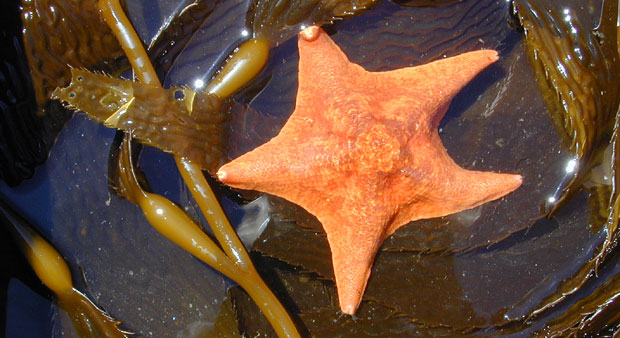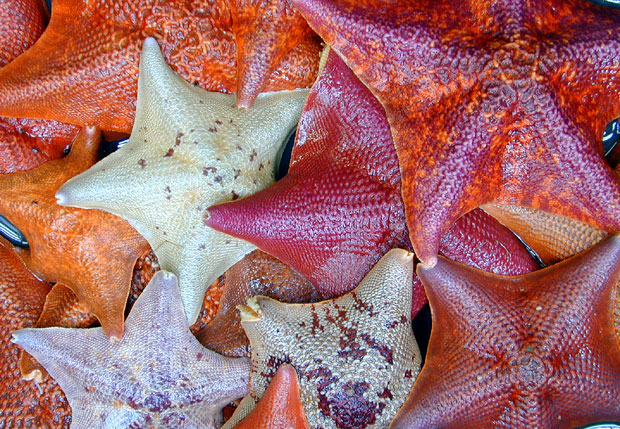Naming| Naming things has been something that people have done for centuries - we name our children, our pets, places we have been, and things we have seen. Sometimes it is easy to know what name to use and other times it may be difficult (if we don't know what something is, where it is, or if it is our responsibility to pick a new name). When describing life forms (I like to call all life forms 'critters'), especially marine life forms, the name may be easy or it may be difficult. Sometimes finding the right name can be a stumbling block to enjoying the beauty of the critter and the stories that describe it may not be interesting if we have trouble naming it. A discussion about naming is important at this stage in the course. And, after reading this, remember that it is just a name. If it troubles you and/or is hard to pronounce don't let it worry you - treat it just like it was a name for a friend. |
 |
One of the common sea stars in California has the common name 'Bat Sea Star' because it has webbing between its legs. (GA image) |
| Common names are usually known by many people who live in the area and would be commonly understood if used. One of the first things most people do when they come across a life form (critter) is to give it a name. This name is generally a 'common name.' It is also usually in the language spoken by the people in that area. There are no real rules for common names but they are generally not capitalized. These common names are a great starting place, however when you move to a different location (or country) the common name may be different for the same critter. If another language is spoken there then the local name may be in the local language. Although most people find common names easier to use, it is the 'scientific name' that needs to be used to avoid problems with misidentifications. |
The scientific name of the bat sea star is Patiria miniata. The genus is Patiria and the species is miniata. Its underside is seen here with a symbiotic worm. (GA image) |
| Scientific names are made of Greek and Latin word roots. They are usually in two parts - first a genus name and second a species name. The genus and species names combined make up what we call the full 'scientific name.' The genus is always capitalized and the species is never capitalized. Both genus and species are set apart from other text by being italicized or underlined. Scientific names have international acceptance so there is never a problem with identification if they are used. They may be hard to pronounce (because they are usually made of Greek and Latin word roots) but you can make it a fun game to learn their proper pronunciation. |
| A classification system started in the mid 1700s to help people communicate about Earth's critters. This was during the early part of the Age of Discovery when some of the first explorers were bringing back new plants and animals to share with each other. The early explorers were naming these different things (usually in their own language) without any particular pattern. When explorers and naturalists (those interested in the natural world) would get together in Europe in the 1600s and early 1700s there was a lot of discussion as to whose name was the 'real' name for the critters that were brought back from across the seas. It became very apparent that a classification and naming system was needed. There were many ideas but it was not until a Swedish botanist (one who studies plants) presented a hierarchical system (based on names that were of Greek and Latin word roots) that these early scientists adopted a specific system. Because almost all 'learned' men (like the naturalists and explorers) of this time were schooled in Greek and Latin, the language problems disappeared and this made it easy for people from all countries to agree to use this system. At this time there were not many species known so it was not that difficult to assign scientific names. |
 (GA image) (GA image) |
The scientific classification of the bat sea star is as follows:
Kingdom Animalia
Phylum Echinodermata
Subphylum Eleutherozoa
Superclass Asterozoa
Class Asteroidea
Order Spinulosida
Suborder Leptognathina
Family Asterinidae
Genus Patiria
Species miniata.
|
A hierarchical system with categories called 'taxa' is recognized, internationally, today. This is basically the same system that Carolus Linnaeus (the Swedish botanist) detailed in the mid 1700s. It involves broad groupings, each with subgroups. The broadest group (most inclusive) is called a kingdom. Each kingdom has subgroups called phyla. Each phylum has subgroups called classes. Each class has subgroups called orders. Each order has subgroups called families. Each family has subgroups called genera. Each genus has subgroups called species. It is the combination of the last two (most specific) subgroups (taxa) that makes up the 'scientific name.' Additional groupings can be made by having these taxa with a sub (lower than) or super (greater than) prefix - so three times as many groupings can be added but this is usually not necessary.
Kingdom
Phylum
Class
Order
Family
Genus
species
|
 |
The bat sea star, Patiria miniata, comes in a wide variety of colors and patterns although they are all the same species. (GA image) |
| A species is defined as a group of individuals that have the possibility of reproducing with resulting fertile offspring. This species concept is where scientists decide when a new species has been found. There is always variation among species (such as the human species, Homo sapiens, with so many different hair, skin, and eye colors but we can all potentially interbreed). There are rare instances where two species can interbreed and a 'hybrid' is produced but this is rare and the hybrid is usually sterile. In the marine environment there are hybrid abalones and some fish. |
| The major types of marine organisms come in many groups, especially animals. In fact, the marine environment has more animal diversity, as far as the major groups are concerned, than almost any other habitat. There are species from almost every major taxa. Below is a short list of the most common marine critters (found in almost all the oceans) and their common names. |
Kingdom Protoctista
Phylum Chlorophyta (green algae)
Phylum Rhodophyta (red algae)
Phylum Phaeophyta (brown algae)
Phylum Bacillariophyta (diatoms)
Phylum Dinomastigota (dinoflagellates)
Kingdom Plantae
Phylum Anthophyta (seagrasses)
Kingdom Animalia
Phylum Porifera (sponges)
Phylum Cnidaria (hydroids, jellyfish, sea anemones, corals)
Phylum Platyhelminthes (flatworms)
Phylum Annelida (segmented worms and vent worms)
Phylum Mollusca (chitons, snails, slugs, bivalves, octopods, squids)
Phylum Arthropoda (crabs, lobsters, shrimp, barnacles)
Phylum Echinodermata (sea stars, brittle stars, sea urchins, sand dollars, sea cucumbers)
Phylum Chordata, synonym = Craniata (subphylum Tunicata, synonym is Urochordata = sea squirts, salps, larvaceans and
subphylum Vertebrata, synonym is Craniata = sharks, rays, fish, reptiles, birds, mammals)
|
| Scientific names and classification taxa generally do not change however, if new information is discovered then there can be changes proposed. For example, the bat sea star had been classified in the genus Patiria but was changed to the genus Asterina for several years until recently it was returned to Patiria by the experts. It used to be hard to keep up with the name changes until recently when the Integrated Taxonomic Information System, or ITIS, website (http://www.itis.gov) has become one of the more accepted ways of checking on any name changes. |
| As was mentioned at the beginning of this lesson be sure not to ever let a name worry you - now you see why the scientific names are composed of Greek and Latin. It was just timing - no longer are 'learned' people (like college educated) required to know Greek and Latin but this was not the case in the 1700s. Almost everyone has trouble with the scientific name pronunciation so you now know that you just pass over the name and not let it bother you. |
|

